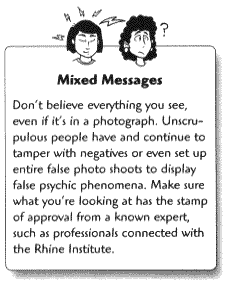|
|
|
|
|
|
|
The most famous thoughtographer, who brought the art form into the spotlight in the 1960s, was Ted Serios. This quirky character would select an existing photograph from a book or postcard, concentrate on the image while showing great physical exertion, and then snap a photo of his face. Not surprisingly, many photos showed his blurred face, or appeared entirely black or white, but the occasional photo did show an image (or some portion of it) from the original photograph. |
|
|
|
|
|
|
|
|
 |
|
|
|
|
|
|
|
|
There are a number of theories on how thoughtography works. It could be that thoughtographers use psychic force to manipulate chemical particles on film, or they might be able to project an invisible image that the film picks up. The other possibility is, of course, that they're frauds and some of them certainly could be. On the other hand, some thoughtography experiments have been performed under stringent controls. Indeed, one Japanese thoughtographer, Masuaki Kiyota, worked differently than Serios: He produced several photos with the lens actually covered. Clearly, he was not placing some infinitesimally small image against the lens when the photo was snapped. This suggests that the power of thoughtography comes directly from the mind, not transferred through the psychic's face or through the light and shadows in front of the lens. Of course, psychic photography isn't for everyone. Indeed, it's probably one of the more offbeat specialties a PK practitioner can get into. But you might find it interesting to know about, and even fun to try your own experimentif you ever have one last shot to use up on a roll of film. |
|
|
|
|
|
|
|
|
Remote Sensing and Its Offshoots |
|
|
|
|
|
|
|
|
In contrastto taking psychic photographs, remote viewing enables a person to perceive a distant image in his or her mind's eye. Although this perceptual ability originally applied only to seeing from afar, the more up-to-date modern term remote perception includes any type of sensory data perceived from a distance. |
|
|
|
|
|